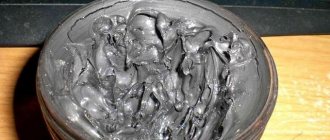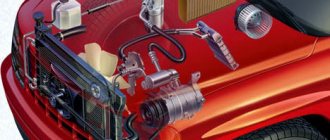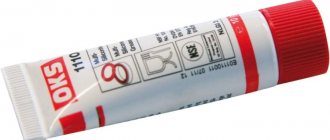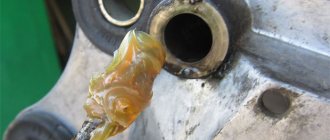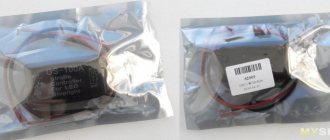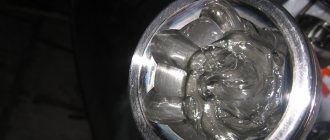Short description
The ZMZ-511 engine and its modifications are used for installation on medium-duty trucks, such as GAZ-53, GAZ-66, GAZ-3307. ZMZ-511 is a modernized ZMZ-53a, 53-11. The ZMZ-511 uses an untuned single-tier intake manifold, which leads to flow pulsations that negatively affect mixture formation. Cylinder heads with highly turbulent combustion chambers and helical inlet ports are used. These heads provide a compression ratio of 7.6:1, versus 6.7:1 for older engines. The ZMZ-513 engine is a modification of the 511 designed for more difficult operating conditions (for military equipment, for transporting goods in rural areas and in other difficult conditions). The engine has a number of design differences, such as a specially shaped sump for the drive axle, shielded design of electrical components, etc. The power and torque characteristics are the same. The ZMZ-513 engine is distinguished by its heavy weight - 275 kg.
Second modernization
The next modernization of the base model (GAZ-53-12) took place only in 1983. The modernization again affected the increase in carrying capacity - now it was 4500 kg. The truck began to be equipped with an improved ZMZ engine model 53-11. The engine received new block heads with screw-shaped intake channels, a compression ratio increased to 7.0 (for A76 gasoline) and a K 135 carburetor. Thanks to these changes, the engine gained 5 hp. maximum power and consumed 5-7% (depending on the operating mode) less fuel.
Starting in January 1988, as part of a further modernization program, the engine received the next generation of cylinder heads. In addition to screw inlet ports, the heads were equipped with specially shaped (highly turbulent) combustion chambers. The heads were produced in two types - with a compression ratio of 7.0 and with a compression ratio of 7.6. Regardless of the type of head, the fuel was A76 gasoline. At the same time, pistons of a modified profile appeared with reduced-height grooves for compression rings. The material of the piston rings themselves has also changed.
- engine;
- front suspension;
- front axle;
- clutch;
- Transmission;
- parking brake;
- cardan shaft;
- vacuum brake booster;
- rear suspension;
- rear axle;
- car;
- steering wheel.
Characteristics of the ZMZ-511/513 GAZ-53, 3307, GAZ-66 engine
| Parameter | Meaning |
| Configuration | V |
| Number of cylinders | 8 |
| Volume, l | 4,254 |
| Cylinder diameter, mm | 92 |
| Piston stroke, mm | 80 |
| Compression ratio | 7,6 |
| Number of valves per cylinder | 2 (1-inlet; 1-outlet) |
| Gas distribution mechanism | OHV |
| Cylinder operating order | 1-5-4-2-6-3-7-8 |
| Rated engine power / at engine speed | 92 kW – (125 hp) / 3400 rpm |
| Maximum torque/at engine speed | 294 N•m / 2000-2500 rpm |
| Supply system | Carburetor K135 |
| Recommended minimum octane number of gasoline | 76 – 80 |
| Environmental standards | Euro 0 |
| Weight, kg | 262 |
Description of the GAZ-3307 (3307) model
Modifications of the GAZ-3307 car:
– GAZ-330701 — version “HL” for cold climates; – export - GAZ-330706 - for countries with a temperate climate and GAZ-330707 - for countries with a tropical climate; – GAZ-33073 – cargo-passenger taxi; – GAZ-33075 and GAZ-33076 - gas cylinders, operating respectively on liquefied petroleum gas (propane-butane) and compressed natural gas; – GAZ-33072 – chassis for dump trucks; – GAZ-33074 – chassis for buses; – GAZ-3307 – chassis for specialized vehicles.
Load capacity, kg - 4500
Curb weight, kg - 3200 Including: front axle, kg - 1435 rear axle, kg - 1765
Gross weight, kg - 7850 Including: front axle, kg - 1875 rear axle, kg - 5975
Permissible trailer weight: with inertial-hydraulic brake drive, kg - 3500 not equipped with a brake system, kg - 750
Maximum vehicle speed, km/h - 90 Same, road trains, km/h - 80 Minimum sustainable speed in low gear, km/h - 5-6 Acceleration time of vehicles to 60 km/h, s - 32
Maximum surmountable incline by cars - 25% Same as by road train - 18% Run-down of cars from 50 km/h, m - 660 Braking distance of cars from 50 km/h, m - 25
Control fuel consumption of cars: l/100 km: at 60 km/h, l - 19.6 at 80 km/h, l - 26.4
Turning radius: on the outer wheel, m - 8 Overall, m - 9
Engine
Modification ZMZ-53-1 1, gasoline, V-shaped (900), 8 cylinders, 92×80 mm, 4.25 l, compression ratio - 7.6, operating order - 1-5-4-2-6 -3-7-8, power 88.5 kW (120 hp) at 3200 rpm, torque - 284.5 (29 kgf m) at 2000–2500 rpm, carburetor - K-135, air filter - inertia-oil. The installation of a pre-heater PZHB-1 2 heat with a capacity of 10,400 kcal/h (power 1-2 kW) is provided.
Transmission
The clutch is single-disk, with peripheral springs, the release drive is hydraulic. Gearbox - 4-speed, gear ratios: I - 6.55; II - 3.09; III - 1.71; IV - 1.0; ZH - 7.77. The cardan transmission consists of two shafts with an intermediate support. The main gear is a single hypoid, gear ratio is 6.17.
Wheels and tires
Wheels - disc, rim. 6.0B-20 with side rings, fastening with 6 studs. Tires - 8.25R20 (240R508) models U-2 (K-84) or K-55A, tire pressure on the front wheels - 4.5 kgf/cm2; rear - 6.3 kgf/cm2. Number of wheels - 6+1
Suspension
Dependent: front - on semi-elliptic springs with shock absorbers; rear - on semi-elliptic springs with additional springs; the ends of the main sheets of all springs are installed in rubber pads of the support brackets.
Brakes
The service brake system has drum mechanisms with a diameter of 380 mm, the width of the front linings is 80 mm, the rear linings are 100 mm, a dual-circuit hydraulic drive (separate along the axes), and a hydraulic vacuum booster. The parking brake is a transmission drum (diameter 220 mm, lining width 60 mm), with a mechanical drive. Spare brake - any of the circuits of the service brake system.
Steering
The steering mechanism is a globoidal worm with a three-ridge roller, the gear ratio is 21.3.
Electrical equipment
Voltage - 12 V battery - 6ST-75 generator - G250-G2 voltage regulator - 222.3702 starter - 230-A1 ignition coil - B114-B (B116) ignition switch - TK102A (13.3734 or 13.3734-01) additional resistor - SE107 (14.3729) )1 distributor (sensor-distributor) - P133-B (24.3706) spark plugs - A11-30.
Filling volumes and recommended operating materials
Fuel tank 105 l gasoline A-76; cooling system (with heater), l - 23 water or antifreeze - A40, antifreeze - A65 engine lubrication system, l - 10 all-season M-8V or M-6/10V (DV-ASZp-10V). at temperatures below −20°C oil ASZp-6 (M-4z/BV), (replacement - all-season ASZp-10) gearbox - 3.0 l. all-season TAP-1 5v. at temperatures below −25°С oil TSp-10 or TSz-9gip (replacement - all-season) TSp-15K, at temperatures below −30°С a mixture of TSp-15K with 10-15% diesel. fuel 3 or A); final drive housing - 8.2 l all-season TSp-14gip, at temperatures below −35°C TSz-9gip (replacement - at temperatures below −35°C a mixture of TSp-14gni oil with 10-15% diesel fuel 3 or A) ; steering gear housing - 0.6 l, the same as for the gearbox; shock absorbers 2×0.41 l, shock absorber fluid AZh-1 2T (substitute - spindle oil AU); hydraulic brakes and clutch releases - 1.35 and 0.25 liters, respectively, "Tom" brake fluid (substitute - "Neva"); windshield washer reservoir - 1.5 l. NIISS-4 liquid mixed with water.
Cylinder block
The ZMZ-511 cylinder block is cast from aluminum alloy. Sleeves with bottom fixation are installed on the engines, they are pressed with a head on top, and the sleeves are sealed with copper rings from below. To improve the rigidity of the block, its lower part is located 75 mm below the crankshaft axis.
| Parameter | Meaning |
| Material | Aluminum alloy AL-4 |
| Cylinder diameter, mm | 92,00 |
| Intercylinder distance (distance between the axes of adjacent cylinders of the block), mm | 123,00 |
| Diameter of boring of crankshaft supports (for main bearings), mm | 67,0 |
| Weight, kg | 44 |
The material of the sleeves is special alloy cast iron. The height of the sleeves is 153 mm. Bore diameter – 100 mm.
Piston
| Parameter | Meaning |
| Diameter, mm | 92,00-91,988 |
| Compression height, mm | 51,0 |
| Weight, g | 565 |
The piston pin has an outer diameter of 25 mm, an inner diameter of 16 mm.
The Soviet Union produced many nice trucks. But among them all, the GAZ-53 stands out. Serial production of the 53rd GAZ began in 1961 and ended in 1993. During the entire existence of this model, GAZ 53 trucks were equipped with internal combustion engines (ICE) from the Gorky Automobile Plant and the Zavolzhsky Motor Plant.
An example of a classic GAZ 53 truck
Oil sump of a GAZ-53 car
The crankcase is stamped from sheet steel and secured to the bottom of the cylinder block using studs. The crankcase flange is sealed using a cork gasket. At the bottom of the pan there is a drain plug sealed with a metal-asbestos gasket. The crankcase oil receiver is a mesh, non-floating type.
Oil radiator
The radiator is made of a thick-walled aluminum tube formed into a coil with five straight sections. The straight sections of the oil cooler have fins for cooling the oil. The radiator is connected to the engine using rubber hoses.
There are equipment, cars that become a symbol of the times. When people of the older generation remember the late Soviet era, they also remember this car, Gaz 53. It was produced at the Gorky Automobile Plant.
Production of this car began in the 60s. There were several modifications of this 3rd generation technique. The car was produced until 1993. Over 30 years, more than 4 million cars were produced. A medium-tonnage truck with a capacity of 3 to 4.5 tons became the most popular truck in Soviet times. History Gas 53
rich. This machine served the entire national economy of the USSR for a long time and reliably. The surviving working machines are still used in agriculture, construction sites, and public utilities.
Modifications of Gas 53 were produced in a certain order. From the start of production of the car until 1967, it was branded F. Then a truck with the letter A began to be produced - a more load-bearing vehicle and stronger. Then, in 1984, the Gas 53-19 and 53-27 models were launched. The latter has a propane-powered engine. All cars were produced in parallel, for different needs. Here is a photo of the onboard Gas 53:
This truck became the pride of the Soviet automobile industry. It was also exported abroad. Many countries bought the car. Comfortable, durable. Another modification began to take a load of up to 4.5 tons. Photo Gas 53:
From the history
From the fall of 1961 to January 1967, Gorky produced the GAZ 53 with the index “F”; the GAZ 53F was powered by the six-cylinder GAZ 51 engine. Although the engine was somewhat improved at that time, it had significant drawbacks.
The internal combustion engine was already obsolete by that time. The lower arrangement of the valves gave low efficiency and low power; the engine was inconvenient to maintain and repair. Even adjusting the valves was a problem, and it took a lot of time to adjust them. The cast iron structure had considerable weight, the motor had a relatively short mileage. Everything was moving towards replacing the outdated design with something more acceptable.
Example of an engine for GAZ 53
At the end of 1958, the Trans-Volga enterprise mastered the casting of aluminum alloys, and the plant began to develop the production of new light metal parts.
At the time, this was a big step forward in the automobile industry.
First, ZMZ designed a V-shaped 8-cylinder engine for the GAZ 13 “Chaika” (ZMZ 13). The engine had a power of 195 horsepower and ran on high octane gasoline (Ai-93 or Ai-95). Almost immediately, the ZMZ 41 internal combustion engine (140 hp) was developed. ZMZ 41 ran on “seventy-sixth” gasoline. This engine was installed on the Volgas of the special services.
This is what a V-shaped 8-cylinder internal combustion engine looks like
ZMZ-511 today
It is difficult to say how many eight-cylinder engines ZMZ has produced from 1964 to the present. More than 4 million GAZ-53s alone were produced in various versions. In addition, variant versions of this engine were equipped with GAZ-66, buses from the PAZ and KAVZ factories. Therefore, today hundreds of thousands of such engines remain in service. According to information from the website of the ZMZ plant, the production of two types of “eights” with a cylinder capacity of 4.25 liters (ZMZ 513.10 and ZMZ 511.10), which trace their lineage back to the ZMZ 53, is currently ongoing.
New engine for GAZ 53A
In 1964, the Zavolzhsky Motor Plant, based on the ZMZ 41 engine, developed a new engine that was equipped with the GAZ 53. It should be noted that six-cylinder internal combustion engines were no longer installed on the second generation of “lawns” (GAZ 53A), and in the future only “fifty-thirds” were equipped with V-shaped 8-cylinder engines.
The new internal combustion engine received the ZMZ index 53A. Just like the ZMZ 13, the engine received an aluminum block and two cylinder heads (cylinder heads) made of the same metal. The ZMZ 53A had a number of clear advantages over the outdated six-cylinder internal combustion engine:
- The engine weighed less;
- It had more power and cylinder capacity;
- Fails less often;
- It was more convenient to repair and maintain.
Characteristics of ZMZ 53A
Starting from 1966, the ZMZ 53 engine was installed as standard on GAZ 53A and GAZ 53 12 vehicles. It had an overhead valve arrangement, and the model used a K 126B carburetor. Later a different carburetor was installed (K 135)
Unlike the ZMZ 41, the 53rd engine has a smaller cylinder volume and piston stroke. Some people claim that the parts of these internal combustion engines are interchangeable, but this is absolutely not true. The engines even have different cylinder blocks, not to mention the piston group, crankshaft and cylinder head. The difference in the blocks is that the seats for the cylinder liners are of different diameters, so replacing one block with another will be extremely problematic.
Possible breakdowns of ZMZ-53
Among the most common malfunctions of the ZMZ-53 engine, the following should be noted:
- Increased fuel consumption. The cause may be an oil leak through the seals or other connections.
- Burnout of engine oil seals occurs due to overheating of the unit.
- The knocking of the connecting rod bearing occurs due to a decrease in the oil level, pressure in the system and wear of spare parts.
- Tapping of the upper bushing and the stroke of the piston means a crack in the skirt and partition of the piston ring, burnout of the bottom.
- The exhaust valve is burnt out - this is due to low-quality fuel, as well as oil getting on the valve and narrowing the gap in the valve.
Modifications of GAZ 53 engines
Many different modifications were created based on the ZMZ 53A engine. Changes in the design suggested some improvements, or were intended to make it possible to install the internal combustion engine on other equipment. For example, the ZMZ 66 06 engine had a compression ratio of 7.6 and its power was increased to 120 hp.
Nowadays, the Zavolzhsky Motor Plant still produces engines for the GAZ 53 and subsequent generations (GAZ 3307, GAZ 3308). ICEs of this type are also used on buses of the Pavlovsk Bus Plant.
Engine diagram for GAZ 53 truck
- ZMZ 66 06, piston stroke/diameter 92x80 mm, volume 4.25 l, power 120 hp, compression ratio 7.6;
- ZMZ 511, piston stroke/diameter 92x80 mm, volume 4.25 l, power 125 hp, compression ratio 7.6;
- ZMZ-523, piston stroke/diameter 92x88 mm, volume 4.68 l, power 130 hp, compression ratio 7.6.
The ZMZ 513 engine is a modernized version of the ZMZ 66 06 engine, ZMZ 5233.10 is installed on GAZ 3307 and GAZ 3308 vehicles, the ZMZ-5234.10 model is intended for PAZ buses.
GAZ-53 (53A) in our time
The GAZ-53 and its variations were produced for almost 30 years, but today many cars are still in active use. Some of them have already been converted to diesel engines, but many still drive with their original “heart”. The main drawback is the GAZ-53 gasoline engine, the technical characteristics of which (primarily efficiency) do not always correspond to modern realities. In addition, owners criticize the uncomfortable and cold cabin with a hard and uncomfortable seat, and the steering without power steering. But many put up with these shortcomings and note the ease of operation and repair (which is especially important in the outback), the versatility of the GAZ-53 chassis, the technical characteristics of which are at an acceptable level and, of course, the low price of the car.
There are a lot of add-ons based on the GAZ-53 - sewage disposal vehicles, tanks for transporting various liquids, vans, dump trucks, utility vehicles, fire fighting equipment and many others.
Main malfunctions of ZMZ 53 engines
Like any other engine, the ZMZ 53 has its weaknesses. Little depends on the modification; all internal combustion engines have similar characteristics.
- insufficient oil pressure in the lubrication system;
- deformation of the intake manifold (“spider”);
- oil leak from the rear main bearing;
- increased oil consumption;
- Under heavy loads, scuffing of the crankpin journals of the crankshaft occurs.
Nevertheless, the engines of this series are quite durable. If you consider the kind of motor oil that is sometimes poured into them, one can only be surprised at the tolerance of the internal combustion engine. Not every foreign-made engine can withstand such abuse.
You often hear from drivers of lawn cars, “That’s it, the engine is running out.” So, it can “end” for almost years. Without pressure, with a smoking piston and high oil consumption, the “lawn” drives for a long time. Very often, and sometimes for a long time, something knocks on “Gazonov” engines, but what exactly is not clear even after disassembling the unit. Surprising but true.
Engine overhaul
With proper care, the GAZ-53 engine rarely needs major repairs, but if this does happen, the following malfunctions may be the cause:
- Increased lubricant consumption, and with the replacement of rings the problem remained relevant.
- Low pressure in the lubrication system and knocking noises in the engine.
- Wear of the entire power unit with exhaustion of its working life.
- Engine jamming due to the crankshaft.
Engine repairs can be carried out independently - the manufacturer issues a complete operating manual, in which all steps for changing parts and possible malfunctions and methods for eliminating them are described in detail.
Despite everything, the engines installed on the GAZ-53 are distinguished by good endurance. Considering the various “modifications” of the internal combustion engine and the oils that are sometimes poured into it, one can only be surprised at its performance. Often such an engine can function quietly for years, even if there are strange knocking noises.
» GAZ-53 engine lubrication system
The lubrication system of the GAZ 53 car is combined, in which oil is supplied to the engine under pressure, by splashing and by gravity. The engine oil located in the engine oil pan is sucked into the oil pump using an oil receiver. Next, the oil under pressure flows through the channels in the cylinder block into the full-flow oil filter, and then into the main oil line of the engine. After this, oil is supplied through channels in the block to the camshaft supports and crankshaft main bearings. Through drillings in the crankshaft, oil from the main bearings is supplied to the cavities of the connecting rod journals and through holes in the connecting rod journals to the connecting rod bearings. Due to centrifugal forces, the oil undergoes additional purification in the cavities of the connecting rod journals.
From the second and fourth camshaft supports, engine oil is supplied through channels in the heads and block to the rocker arm axles. From the inside of the rocker arm axis, oil is supplied through the holes to the rocker arm bearings. Then, through the grooves on the rocker arm bushings, holes in the rocker arms and adjusting screws, the oil flows to the upper tips of the rods. Flowing down the pusher rods, the oil is supplied to the lower tips and drains through the holes in the pushers into the oil pan, lubricating the pusher guides and their end parts.
Diagram of the GAZ-53 smearing system:
1 - oil cooler;
2 — cavity of the rocker arm axis; 3 — channel in the cylinder head; 4 — oil filter; 5 — channel in the cylinder block; 6 - main oil line; 7 — hole in the distributor drive housing; 8 - cavity; 9 — oil pump; 10 - pressure reducing valve; 11 - fourth camshaft journal; 12 — oil receiver; 13 - safety valve; 14 — oil radiator tap; 15 - second camshaft journal. The camshaft thrust flange is lubricated by a flat and a hole in the front camshaft support. The drive gears are lubricated through a tube from the main oil line. The oil pump drive and its gears are lubricated with oil, which is supplied from the cavity located between the plug in the cylinder block and the fifth camshaft journal. The remaining parts that need lubrication receive oil supplied by gravity or splashing.
The oil pressure in the gas 53 lubrication system must be at least 250 kPa when the vehicle is moving at a speed of 55 km/h in direct gear with a well-warmed-up engine and the oil cooler turned off. During engine startup and warm-up, oil pressure can reach 500-550 kPa.
If the oil in the engine oil line drops to 40-80 kPa, the emergency oil pressure light on the instrument panel will light up. The warning light is allowed to light up at low crankshaft speeds in idle mode. If the lubrication system is working properly, the warning light will go out as the rotation speed increases. If the light comes on at medium or high speeds, this indicates the presence of some kind of malfunction in the lubrication system.
If the ambient temperature is more than 20º C and when the vehicle is operated in difficult road conditions, it is necessary to turn on the oil cooler by opening the tap located on the left side of the engine. When the radiator is turned on, the faucet handle is located along the axis of the hose. Oil is supplied to the radiator only when the tap is open through the safety valve. The valve opens when the pressure in the lubrication system reaches about 100 kPa. After passing through the radiator, the engine oil is drained into the engine sump.
Correct engine maintenance
The engine itself is good and does not cause any complaints; the main thing is to maintain its technical condition.
This is what the internal combustion engine looks like for a GAZ 53 car
When carrying out maintenance, the cylinder head must be tightened.
But these are the first three technical inspections, then the frequency can be increased and the cylinder head can be tightened after each TO-2.
Don't forget about the temperature.
To help your engine last longer, replace the piston rings as soon as necessary. The car itself will tell you that it is time to replace the piston rings. In this case, after every 100 km. mileage the oil will decrease by about 400 grams. If the oil pressure in the system has dropped, then the problem is in the crankshaft main bearing shells, which also need to be replaced immediately.
Engine for GAZ 53 cross-section
Required Engine Maintenance
GAZ-53 engines have good endurance and a long service life. To extend its service life, it is recommended to carry out its maintenance. Timely measures will save money and time.
- Regular change of engine oil - every 6 thousand km traveled. The most suitable oil would be mineral-based or semi-synthetic.
- Periodically (every 1–2 thousand km) the cylinder head is tightened, as well as the spider intake manifold is attached.
- Adjust the valves after replacing the cylinder head gaskets or when tapping.
- When changing cylinder head gaskets or performing scheduled engine repairs, you should immediately tighten the bolts and belts on a cooled GAZ-53 engine. During the period outside of repairs, the condition of the belts is checked after 30 thousand km.
- In the summer, check daily that there is enough coolant in the system, as well as water, to avoid engine overheating.
- Monitor the oil level and the serviceability of the sensors on the dashboard. This should be done by the owners of Volga and UAZ. If there is insufficient oil in the GAZ-53 engine, top it up to avoid repairs.
- External inspection for oil leaks, which is the main possible engine breakdown.
All breakdowns should be repaired immediately as they occur. Disassembly of the GAZ-53 engine is carried out with special tools and experienced employees in the workshop.
Change of oil
You can change the oil in the GAZ-53 engine yourself by performing the following manipulations:
- Unscrew the neck cap and remove the plug from the drain hole to remove residues. It is necessary to take precautions, as you can get burned.
- The plug is screwed into place.
- The filter also needs to be replaced - remove the old one, and pour a little oil into the cavity of the new one.
- Good quality oil is poured into the unit to the proper level.
- The GAZ-53 engine starts and waits 5–7 minutes for all mechanisms to be lubricated.
- The sensor readings are rechecked.
Checking the technical condition of the internal combustion engine ZMZ 53
Some indicators can be used to judge the technical condition of the engine. These indicators are:
- oil consumption per 100 (1000) km;
- oil pressure values at idle and medium crankshaft speeds;
- compression in internal combustion engine cylinders.
Oil consumption is checked by level with a dipstick on a cold, unstarted engine. If consumption exceeds 0.4 liters per 100 km, the engine needs to be repaired. But the internal combustion engine can also be repaired with less oil consumption, especially when there are no leaks on the engine.
Oil pressure is controlled by a dial indicator and a warning lamp on the instrument panel. Sometimes sensors are faulty. Accurate readings can be obtained using a control pressure gauge. The minimum pressure at idle speed of the internal combustion engine should not be less than 0.5 kg/cm², at medium speeds this figure should not fall below 1 kg/cm². If the values are lower, the engine is sent for repair.
Compression in internal combustion engine cylinders is measured with a compression meter. This operation must be carried out by two people. Compression is measured with the spark plugs turned out, the throttle valve fully open, on a good battery and the power supply to the high-voltage wires is turned off. Good compression on ZMZ 53 is considered to be 7.5 kg/cm².
Engine Specifications
Below are the technical characteristics of the ZMZ 511.1000398 engine for GAZ-53 GAZ-3307 and AI-76
The engine is carburetor, gasoline, with a V-shaped arrangement of cylinders at an angle of 90 degrees and an overhead valve arrangement.
The engine uses cylinder heads with highly turbulent combustion chambers and helical intake ports. All engines use an exhaust gas recirculation system to reduce emissions of harmful substances into the atmosphere. The engines have a clutch housing for a unified gearbox.
- number of cylinders - 8;
- operating mode - 4-stroke;
- compression ratio - 7.6:1;
- working volume, l - 4.25;
- rated power at a crankshaft speed of 3200-3400 1/min, kW (hp) - 92 (125);
- maximum torque at a crankshaft speed of 2000-2500 1/min, N*m (kgf*m) - 294 (30);
- minimum specific fuel consumption g/kW*h (g/l. S.*h) - 286 (210);
- oil consumption for waste, % of fuel consumption - 0.4;
- weight, kg - 262;
- fuel - A-76.
External speed characteristics of the engine.
By complying with all requirements, the GAZ 53 engine will serve you and your children.
Tuning options
In order to give a more attractive look and improve the performance of the GAZ-53 engine, the following types of tuning are practiced:
- A complete replacement of the engine involves the installation of a diesel, more powerful engine. At the same time, fuel consumption is reduced and the service life is increased to 400 thousand km. And also servicing the motor will not be difficult.
- The fasteners are welded, the fuel tank, electrical wiring, exhaust system are changed, and the driveshaft is remade.
- Updating the cabin on a GAZ-53 car involves installing a central locking and alarm system.
- Replacement of the rear axle from GAZ-3307. This is characterized by a particularly robust suspension and a self-locking rear axle.
- Transmission upgrade - it is recommended to replace the gearbox from the GAZ-3309.
